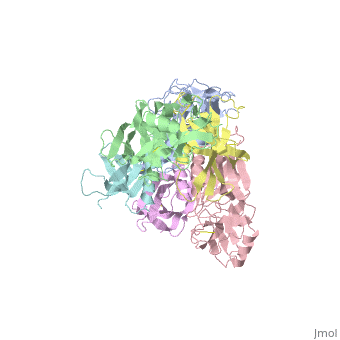1prt
From Proteopedia
| Line 7: | Line 7: | ||
|ACTIVITY= | |ACTIVITY= | ||
|GENE= | |GENE= | ||
| + | |DOMAIN= | ||
| + | |RELATEDENTRY= | ||
| + | |RESOURCES=<span class='plainlinks'>[http://oca.weizmann.ac.il/oca-docs/fgij/fg.htm?mol=1prt FirstGlance], [http://oca.weizmann.ac.il/oca-bin/ocaids?id=1prt OCA], [http://www.ebi.ac.uk/pdbsum/1prt PDBsum], [http://www.rcsb.org/pdb/explore.do?structureId=1prt RCSB]</span> | ||
}} | }} | ||
| Line 27: | Line 30: | ||
[[Category: toxin]] | [[Category: toxin]] | ||
| - | ''Page seeded by [http://oca.weizmann.ac.il/oca OCA ] on | + | ''Page seeded by [http://oca.weizmann.ac.il/oca OCA ] on Sun Mar 30 23:03:40 2008'' |
Revision as of 20:03, 30 March 2008
| |||||||
| , resolution 2.9Å | |||||||
|---|---|---|---|---|---|---|---|
| Resources: | FirstGlance, OCA, PDBsum, RCSB | ||||||
| Coordinates: | save as pdb, mmCIF, xml | ||||||
THE CRYSTAL STRUCTURE OF PERTUSSIS TOXIN
Overview
BACKGROUND: Pertussis toxin is an exotoxin of the A-B class produced by Bordetella pertussis. The holotoxin comprises 952 residues forming six subunits (five different sequences, S1-S5). It plays an important role in the development of protective immunity to whooping cough, and is an essential component of new acellular vaccines. It is also widely used as a biochemical tool to ADP-ribosylate GTP-binding proteins in the study of signal transduction. RESULTS: The crystal structure of pertussis toxin has been determined at 2.9 A resolution. The catalytic A-subunit (S1) shares structural homology with other ADP-ribosylating bacterial toxins, although differences in the carboxy-terminal portion explain its unique activation mechanism. Despite its heterogeneous subunit composition, the structure of the cell-binding B-oligomer (S2, S3, two copies of S4, and S5) resembles the symmetrical B-pentamers of the cholera toxin and Shiga toxin families, but it interacts differently with the A-subunit. The structural similarity is all the more surprising given that there is almost no sequence homology between B-subunits of the different toxins. Two peripheral domains that are unique to the pertussis toxin B-oligomer show unexpected structural homology with a calcium-dependent eukaryotic lectin, and reveal possible receptor-binding sites. CONCLUSION: The structure provides insight into the pathogenic mechanisms of pertussis toxin and the evolution of bacterial toxins. Knowledge of the tertiary structure of the active site forms a rational basis for elimination of catalytic activity in recombinant molecules for vaccine use.
About this Structure
1PRT is a Protein complex structure of sequences from Bordetella pertussis. The following page contains interesting information on the relation of 1PRT with [Cholera Toxin]. Full crystallographic information is available from OCA.
Reference
The crystal structure of pertussis toxin., Stein PE, Boodhoo A, Armstrong GD, Cockle SA, Klein MH, Read RJ, Structure. 1994 Jan 15;2(1):45-57. PMID:8075982
Page seeded by OCA on Sun Mar 30 23:03:40 2008

